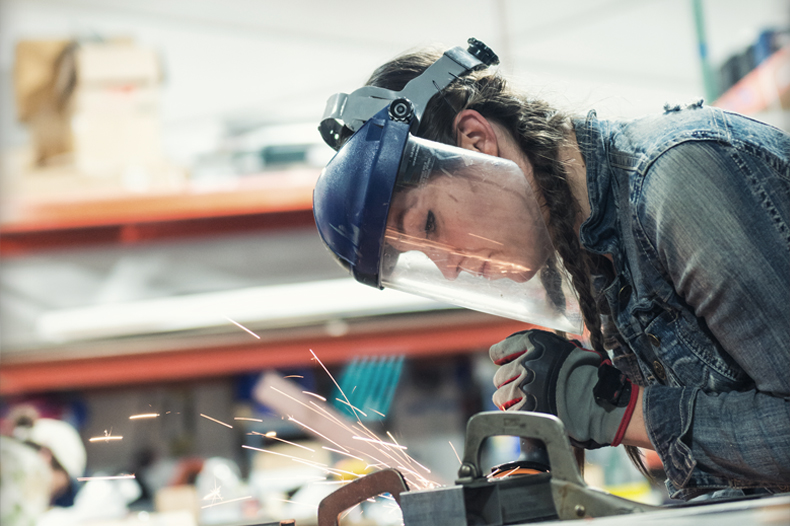From Rosie the Riveter to advanced robotics, manufacturing evolves into the largest sector of the U.S. economy – while employment continues to drop by the millions.
Is it a pivotal moment for this aging industry?
Manufacturing – the transformation of raw materials into products – is big business. It happens in large factories and plants, and in small “ma and pa” operations like jewelers and chocolatiers. No matter the size of the company, one thing’s for sure – the industry ain’t what it used to be.
Blast to the past
When the steam engine came to the U.S. in the late 1700s, manufacturing became as American as apple pie. We were making great strides with the automatic flour mill, cotton gin, and interchangeable parts, something Eli Whitney invented on the fly when he needed to quickly produce 10,000 muskets for the U.S government.
Rolling into the 1800s, coal power and machinery gave rise to the U.S. Industrial Revolution. A century later, we’d see Model T Fords roll off the first moving assembly lines, and Toyota introduce Just-In-Time inventory management and automation. The boom would continue throughout the ‘30s and ‘40s as we supplied the government with jet engines and modern war equipment. Women even entered factories on a large scale to fill the shoes of men overseas – a phenomenon immortalized by Rosie the Riveter.
Eventually, manufacturing met technology. Between 1953 and 1973, we saw the birth of the first CAD software, commercial silicon transistor, programming language, integrated circuit, and industrial robot. At the same time, new regulations protecting workers and the environment – like The International Organization for Standardization (ISO) and Occupational Safety and Health Act (OSHA) – would come into play. The manufacturing industry would never be the same.
Back to the future
Today, manufacturing is recovering from a long decline. Since the beginning of the 21st century, the U.S. has closed the doors of over 63,000 factories, and shed over five million jobs – a third of the industry’s workforce. By 2010, we tanked to the fourth largest manufacturing nation in the world.
The good news is that U.S. manufacturing is currently on a major upswing. By 2013, we jumped a notch to third place, and today we’re neck and neck with China. In 2015, manufacturing drove 9 percent of the country’s economy, amounting to half of all U.S. exports. Still, the total U.S. trade deficit is at $500 billion, and we have a lot of work to do. Low-cost production solutions like overseas outsourcing and robotics continue to push an older generation of workers out of the industry.
One of our biggest misses here is education. The manufacturing jobs exist – we just don’t have workers with the right skills to fill them. In 2011, executives from over 450 manufacturing companies reported that over 600,000 jobs were left unfilled due to a lack of qualified applicants. Today, the number of open positions is higher than it’s been in 15 years. The U.S. averaged 353,000 openings per month in 2016. Over the next decade, it’s expected that 3.5 million more manufacturing jobs will be created, yet two million will go unfilled.
While many long for the good old days when one in every four U.S. workers were employed in manufacturing, those days are long gone. Just as we transitioned from farms to factories, we’re now moving from factories to service and health centers. The positions needed for manufacturing just aren’t what they used to be. The jobs available, though, do pay 12 percent more than other industries, with an average salary of $77,060 – and there are plenty of them.
So, how do we get more workers qualified to do these jobs?
The other tough issue is competition. China is keeping their edge due to lower operating costs. In the U.S., federal regulations are driving the cost of doing business up to 20 percent higher than other countries. We also have twice the tax rate as China, and our lack of bilateral free trade agreements means we pay more for imported supplies. Meanwhile, the U.S. has a higher standard of living, driving up labor costs significantly compared to other countries.
So, how do we compete?
Time for a Change
Struck by the hope of capitalizing on manufacturing momentum, politicians and business leaders alike are coming forward with propositions for creating new jobs and higher profits. Strategies range from shedding regulations to offering education solutions, and taxing imports.
There are a few things it seems we can all agree on. As industries become more efficient, it requires less work to get the job done. In fact, as a result of natural progress and innovation, China has lost more manufacturing jobs than in the US over the past 20 years.
Instead of looking back to the glory days of U.S. manufacturing, perhaps we should be looking forward to investing in affordable and accessible college educations, or advanced training programs in manufacturing. Although bringing back plants are great wins, we need to also remember that the number of laborers required for output will never be the same as it used to be. More trained laborers will ultimately make the difference in job placement.
So what’s the good news?
Locking in the lead
Manufacturing is expected to grow an average of 3 percent annually over the next few years – faster than any other sector. We should see increased productivity due to technology advancements, lower production costs due to increased domestic production of gas and oil. At the same time, the U.S. should start looking more attractive to companies outsourcing overseas as wages continue to rise in competing countries. This, and an increased interest in protecting intellectual property, reducing knock-offs, and purchasing American made products should all work to help drive manufacturing back home.
Manufacturing and transportation
It’s difficult to know exactly how the future of manufacturing will affect the transportation industry. An upswing in one should ultimately lead to an upswing in the other. Transportation has always been an industry employing valuable workers without a college education, so as non-technical jobs decrease in manufacturing, we may see a flood of job seekers in the transportation market. Time will tell how this all plays out. In the meantime, we’ll just keep on truckin’.
Sources:
http://www.nam.org/Newsroom/Facts-About-Manufacturing/
http://visual.ly/us-manufacturing-history
https://www.wsj.com/articles/as-skill-requirements-increase-more-manufacturing-jobs-go-unfilled-1472733676
[amp-cta id=’8469′]



